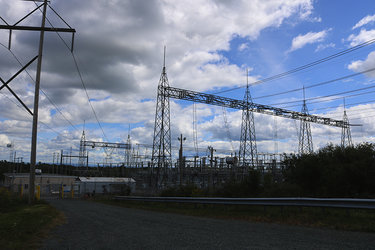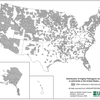Capital Region CCA program on hold as municipalities deal with coronavirus, lower energy prices
Enterprise file photo — Michael Koff
Community Choice Aggregation is a program that allows municipalities to use the collective buying of their residents to drive down energy costs while also being able to choose the source of the generation — renewable energy or regular grid mix. Locally, New Scotland, Voorheesville, Guilderland, and Altamont are involved in the 13-municipality Capital Region Aggregation. But the program has been put on hold as cities, towns, and villages deal with the COVID-19 outbreak.
ALBANY COUNTY — A program that allows municipalities to bargain for cleaner and cheaper electricity is being shelved in part because of a drop in energy prices.
Although wholesale electricity prices are at near two-decade low — and about half of what they were this time last year, locally — that has not been reflected in homeowners’ bills because of the expenses associated with maintaining aged transmission and distribution infrastructure, as well as new costs for implementing the next generation of renewable-energy infrastructure.
Community Choice Aggregation (CCA) gives municipalities the authority to make a local decision about where and from whom their electric customers get their power.
Just before the COVID-19 pandemic shut down the state, the 13 area cities, towns, and villages that make up that Capital Region Aggregation had taken all the required steps to implement the individual CCA program at the municipal level, said Nicole Correia, a project organizer with the Municipal Electric and Gas Alliance, the administrator of the CCA program.
Locally, New Scotland, Voorheesville, Guilderland, and Altamont are involved in the aggregation.
The city of Albany had finalized its CCA local law in early March, and, by early April, the New York Public Service Commission had signed off on Albany and Watervliet joining the program.
The plan, Correia said, was to issue a request for proposals (RFP) this month to find the best electricity rates for the 90,000 households of the Capital Region Aggregation.
“So, we were originally planning to go to bid at the beginning of May, but we heard from municipalities that they weren’t quite ready to do that,” she said. “Obviously, their intentions [are] focused elsewhere; they still want to move forward with CCA, but want to slow the process a little bit.”
There were also some municipalities that listed among their concerns the current unpredictability of the energy market.
But Correia said the pullback was more COVID-based than market-related.
“That’s not so much our concern right now, just because we don’t really know what the prices will look like until we go out to bid for this aggregation,” Correia said. “And a decision doesn’t have to be made after that until you know if the pricing is seen.”
Last week, Michele Madigan, the commissioner of finance for the city of Saratoga Springs, made the decision to put her city’s participation in the Capital Regional CCA program “on pause.”
Among her reasons for doing so, Madigan cited the ongoing health crisis and the lack of transparency, education, and discussion that needs to take place with the community prior to the city council moving forward with the CCA program.
Madigan said that the “energy market has crashed and we do not want to pass along a greater expense to our residents at this time.” She added that MEGA would monitor the energy markets throughout the summer.
Saratoga Springs was the first municipality in the area to formally enroll in what would become the Capital Region Aggregation.
At a separate city council meeting last week, Madigan said that she wouldn’t want to enter into an agreement right now, considering current energy prices, which, she said, “are much lower, even for brown energy, than I believe we could get with a CCA program.”
Residential retail electricity rates across the country have increased by about 15 percent over the past decade, with one exception: New York State’s rates have been comparatively flat over that same period.
For the first two months of 2020, the most recent available data from the New York State Energy Research and Development Authority, the average retail price of residential electricity in New York State was about 17.50 cents per kilowatt hour.
With the exception of 2014 (when it cost 20.05 cents), the average annual retail price of residential electricity in the state has never been more than about 18.80 cents per kilowatt hour.
An electric bill has two main charges — supply and delivery.
Delivery is the physical infrastructure, the power lines, transmission towers, substations, as well as the maintenance. In the Capital Region, National Grid operates and maintains the electricity infrastructure.
Supply is the actual electricity, the physical electrons, that use National Grid’s infrastructure to get from the point of generation to the homes of customers. This is the part of the bill that the MEGA CCA takes over, although it would still appear on a customer’s National Grid bill.
Customers of a MEGA-administered CCA in the Southern Tier have the option to purchase electricity from 100-percent renewable sources for about 5.7 cents per kilowatt hour or a grid-mix that costs about 5.1 cents per kilowatt hour. The local electric supplier, the New York State Electric and Gas Corporation, charges about 5.3 cents per kilowatt hour.
Along with being able to choose the source of their energy, the Southern Tier customers also have two years of fully-fixed rates. And they have the right to opt-out of the program, as the CCA automatically opt-ins all of a municipality’s eligible customers.
In April, the supply charge for National Grid customers in the Capital Region was about 4.2 cents per kilowatt hour.
Form letters from the municipalities that make up the Southern Tier aggregation sent to residential electrical customers state, “The CCA offers competitive and stable rates but there is no guarantee that the price will be lower than NYSEG’s.”
The May 2019 form letters also noted that the only CCA in the state at the time was in Westchester County, which had “realized” $15 million in savings for its customers over a three-year period.
An implementation plan update of the Westchester County CCA, states that savings were “modest, but important,” but goes on to say that the Westchester CCA as well as most other CCAs it had encountered were “primarily driven by the aspiration for environmental improvements”; however,” “program economics are still crucial to [CCA] long-term viability.”
The CCA program is set up to favor municipalities; there’s nothing to be lost on the part of the cities, towns, and villages in the aggregation by going out to bid.
In its request for proposals, MEGA requires bidders to provide rates for different contract terms, for example, what the kilowatt-hour rate would be for 12, 24, or 36 months. The terms and rates are calculated for both grid-mix and renewable-energy generation. At this step, the municipalities can take a look at the RFP and, if they don’t like it, they can walk away, scot-free.
Asked about going out to bid, just to see what’s out there, Correia said, “We’ve had that conversation.” But, even if municipalities want to slow down the process, MEGA, as the administrator, will continue to monitor the energy markets throughout the summer, she said, so that it can help inform the decision about when is the right time to go out to bid.
As for now, Correia said, “We don’t have a solid timeline” for when the program will kick back into gear. She did say that MEGA is “looking at possibly issuing” a request for proposals later in the summer, before adding “but that’s kind of a moving target right now.”
Unintended consequences
COVID-19 has been confirmed in over 4 million cases worldwide, while close to 280,000 people have succumbed to the virus.
The current pandemic, according to the International Energy Agency, “is above all a global health crisis.” But, “beyond the immediate impact on health, the current crisis has major implications for global economies, energy use, and CO2 emissions,” say the opening lines of the International Energy Agency’s 2020 Global Energy Review.
The pandemic’s impact “on the energy industry is unprecedented,” according to S&P Global, a market-research firm.
The worldwide demand for energy during the first three months of this year compared to last year declined by nearly 4 percent, a drop not seen in seven decades.
And worldwide greenhouse-gas emissions were down 5 percent compared to this time last year — and that number is expected to drop even further, “six times larger than the previous record reduction.” In fact, according to the International Energy Agency, the reduction in greenhouse gases would be the largest ever.
Closer to home, carbon monoxide emissions in New York City are down by 50 percent.
Daily electricity demand statewide is down about 13 percent since the pandemic began, while “the reduction in electric demand from commercial customers is a leading driver of overall reduced electricity consumption,” according to the New York Independent System Operator. Commercial customers account for more than half of total electricity sales in New York State.
In the Capital Region, energy use was down about 6 percent for the week ending May 2, the most recent available data. For the seven-day period ending April 20, electricity use had fallen 9 percent below typical levels, the deepest drop since the state’s stay-at-home order was issued on March 20.
And because of “low seasonal demand,” and “reduced demand from quarantines,” and “falling input energy prices,” according to Utility Dive, which covers the utility industry, “electricity prices are falling.”
Between March and April, New York City’s real-time locational marginal prices dropped by about 40 percent, from $25 per kilowatt-hour to $15.
Locational marginal pricing, according to energy market research firm, “represents the cost to buy and sell power at different locations within wholesale electricity markets” while day-ahead locational-based marginal pricing allows wholesalers to buy and sell electricity a day in advance to avoid volatility, according to Energy Acuity.
In March, according to New York Independent System Operator, the day-ahead locational-based marginal pricing (LBMP) for a megawatt-hour of power in the Capital Region was $17.05 per megawatt-hour; a year prior, day-ahead pricing was $33.39 per megawatt-hour.
The Capital Region day-ahead LBMP for February was $20.45 per megawatt-hour — in February 2019, day-ahead pricing was $32.72 per megawatt-hour.
On May 10, at 11:50 a.m., the day-ahead locational-based marginal pricing for a megawatt-hour of electricity in the Capital Region was $14.03.
While wholesale electricity costs have dropped to a multi-decade low, that change has not been reflected in the residential retail market nor is it likely to be.
For the first three months of this year, the average wholesale electric energy price in New York State was about $23.39 per megawatt-hour; in 2019, it was $32.13 per megawatt-hour, down from $44.92 per megawatt-hour in 2018.
The increase in renewable-energy generation, inexpensive natural gas, and a sluggish demand increase in the residential retail market have all contributed to the decline in wholesale electricity costs.
But that drop hasn’t been seen in homeowners’ bills because residential retail electricity costs are more and more driven by capital costs associated with maintaining and replacing decades-old transmission and distribution infrastructure.
A 93-mile, $750-million upgrade of transmission lines between Oneida County and New Scotland is slated to begin this year.
Additional capital costs like the building of new renewable-energy generation infrastructure — wind and solar farms, for example — as well as the need for energy-storage technologies mean “fixed costs are becoming a larger fraction of customers’ bills,” according to Helen Lo and her co-authors in an article in the electric-power policy publication The Electricity Journal.


